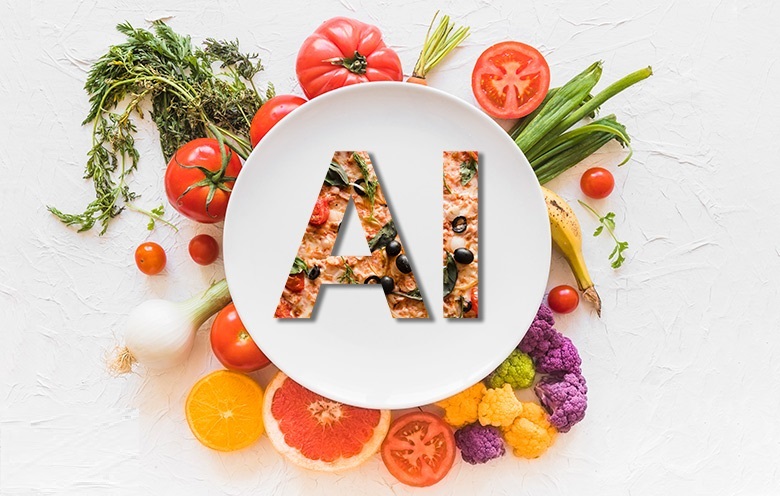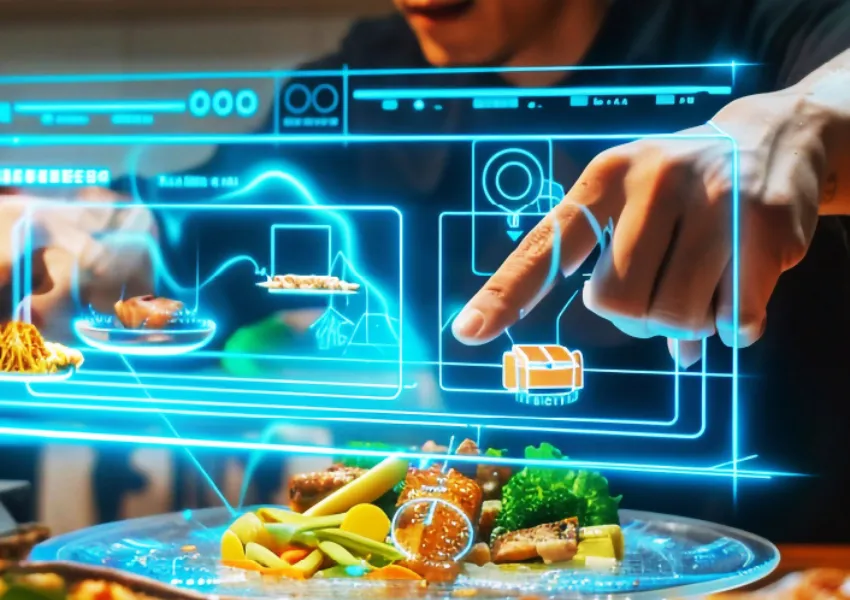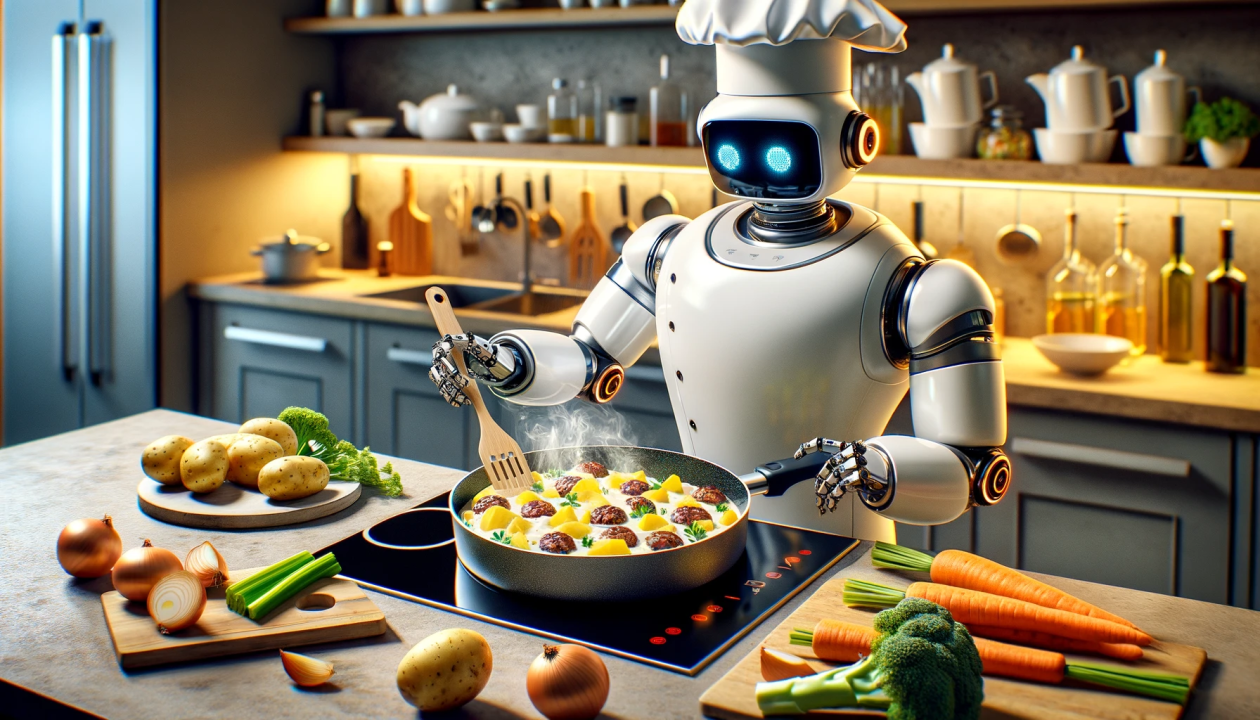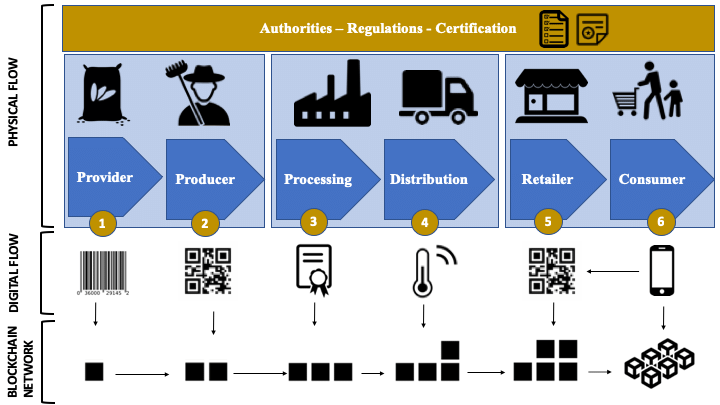
AI Revolutionizing the Food Industry: Key Benefits & Trends
What's in This Article
The AI revolution in the food industry is reshaping how we produce, consume, and think about food. With AI in food industry applications, businesses are optimizing processes and enhancing consumer experiences. From AI recipe creation to AI quality control, the integration of artificial intelligence is driving significant changes. In today's digital age, smart kitchens and data-driven decisions are becoming the norm, influencing consumer behavior and promoting sustainable food systems. This article explores the key benefits and trends of AI in the food industry, highlighting its potential to revolutionize the entire food supply chain and create new opportunities for innovation and growth.

Artificial intelligence is revolutionizing every aspect of the food industry from farm to table
AI in Product Development
AI is playing a pivotal role in accelerating product development within the food industry. By leveraging AI food trends, companies can analyze vast amounts of data to predict consumer preferences and create innovative products. This digital transformation allows for more efficient research and development processes, reducing time-to-market for new food items. For businesses looking to stay competitive, embracing AI-driven product development has become essential rather than optional.
The integration of AI into product development has also led to more targeted creation of foods that meet specific dietary needs and preferences. By analyzing consumer data and market trends, AI systems can identify gaps in the market and guide the development of products tailored to emerging consumer segments, whether that's plant-based alternatives, functional foods, or globally-inspired flavor profiles.
AI-Driven Recipe Creation
AI recipe creation is revolutionizing how new dishes are developed. By analyzing consumer data and culinary trends, AI systems can suggest ingredient combinations and flavor profiles that appeal to diverse palates. This not only enhances culinary innovation but also supports healthy eating by recommending nutritious alternatives. Some cutting-edge AI systems can even analyze the molecular structure of ingredients to predict flavor pairings that human chefs might not consider.
Services like AI Recipe Finder leverage this technology to help home cooks discover new dishes based on ingredients they already have, reducing food waste and expanding culinary horizons. In commercial settings, AI recipe development can shorten product development cycles from months to weeks, giving companies a competitive edge in bringing new products to market.
Enhancing Food Safety
AI technology is crucial in ensuring food safety. By monitoring production processes and identifying potential hazards, AI systems help maintain high-quality standards. This proactive approach to quality control minimizes risks and ensures that consumers receive safe and reliable products. Advanced computer vision systems can detect contaminants, improper packaging, or quality issues at speeds and accuracy levels impossible for human inspectors.
Predictive analytics also allows food manufacturers to anticipate potential safety issues before they occur, by analyzing patterns and identifying risk factors across the supply chain. This shift from reactive to preventive quality control represents one of the most significant impacts of AI in modern food systems, with implications for both consumer safety and regulatory compliance.

AI recipe creation tools can analyze flavor compounds to suggest innovative ingredient combinations
AI in Consumer Engagement
AI is transforming consumer engagement by personalizing experiences and influencing purchasing decisions. Through AI consumer choices, businesses can tailor marketing strategies to individual preferences, enhancing customer satisfaction and loyalty. This personalized approach is a key trend in the AI food industry that extends from product recommendation engines on e-commerce platforms to customized in-store experiences that adapt to consumer behavior in real-time.
The ability of AI to analyze vast amounts of consumer data allows companies to understand not just what consumers are buying, but why they're making those choices. This deeper understanding enables more meaningful connections with customers and more effective product positioning in an increasingly crowded marketplace.
Smart Kitchens and AI
Smart kitchens equipped with AI technology are becoming increasingly popular. These kitchens use AI to automate cooking processes, suggest recipes based on available ingredients, and even manage inventory. This convenience not only saves time but also encourages healthier eating habits by providing easy access to nutritious meals. Connected appliances can communicate with each other to coordinate meal preparation, while smart refrigerators can track food freshness and suggest recipes to use ingredients before they spoil.
The integration of voice assistants and AI-powered cooking guides is making cooking more accessible to people with varying levels of culinary expertise. These technologies can provide step-by-step guidance, answer questions in real-time, and adapt recipes based on available ingredients or dietary preferences. For consumers who use AI-powered recipe tools, these smart kitchen technologies create a seamless ecosystem that supports better food choices and more enjoyable cooking experiences.
Data-Driven Consumer Insights
AI provides valuable insights into consumer behavior by analyzing purchasing patterns and preferences. This data-driven approach allows companies to anticipate trends and adapt their offerings accordingly. By understanding consumer needs, businesses can create more targeted and effective marketing campaigns that resonate with specific customer segments.
Beyond marketing, these insights are informing product development, packaging design, pricing strategies, and even store layouts. Retailers are using AI to analyze foot traffic patterns and product placement effectiveness, while restaurants are leveraging similar technologies to optimize menu designs and pricing for maximum profitability. The result is a more responsive food industry that can quickly adapt to changing consumer preferences and market conditions.

AI-powered smart kitchens are changing how consumers interact with food in their homes
AI in Supply Chain Optimization
AI is revolutionizing supply chain management by optimizing logistics and reducing waste. Through AI food trends, companies can predict demand and adjust production schedules, ensuring efficient resource allocation. This not only reduces costs but also supports sustainable food systems by minimizing environmental impact. The food industry, with its perishable products and complex global supply networks, stands to benefit enormously from these advancements.
The implementation of AI across the supply chain is enabling new levels of transparency and traceability, allowing companies to track products from farm to table. This visibility helps address consumer demands for information about where their food comes from while also facilitating faster responses to safety issues or quality concerns.
Predictive Analytics in Supply Chains
Predictive analytics powered by AI allows companies to forecast demand with greater accuracy. By analyzing historical data and market trends, AI systems can optimize inventory levels and reduce the risk of overproduction. This efficiency is crucial for maintaining a competitive edge in the food industry where margins are often tight and waste can significantly impact profitability.
These systems consider a wide range of variables—from seasonal patterns and weather forecasts to social media trends and economic indicators—to create more accurate demand forecasts. The result is a more agile supply chain that can adapt to changing market conditions and consumer preferences, reducing both food waste and out-of-stock situations that frustrate consumers and impact sales.
Sustainable Food Systems
AI supports sustainable food systems by promoting efficient resource use and reducing waste. By optimizing supply chain processes, AI helps companies minimize their environmental footprint. This commitment to sustainability is increasingly important to consumers and aligns with global efforts to combat climate change and reduce food insecurity.
From precision agriculture that uses AI to optimize water and fertilizer use, to smart packaging that extends shelf life, artificial intelligence is enabling more sustainable practices throughout the food system. These innovations are particularly important as the industry faces increasing pressure to reduce its environmental impact while meeting the demands of a growing global population. The intersection of AI, sustainability, and food production represents one of the most promising frontiers for addressing these complex challenges.

AI optimization in the food supply chain reduces waste and improves sustainability
Future of AI in the Food Industry
The future of AI in the food industry holds immense potential for innovation and growth. As technology continues to evolve, AI will play an even more significant role in shaping the industry's landscape. From AI recipe creation to AI quality control, the possibilities are endless and will likely transform aspects of food production and consumption that we currently take for granted.
The convergence of AI with other emerging technologies like blockchain, IoT, and biotechnology will create new opportunities for innovation and disruption. Companies that embrace these technologies and develop strategies to integrate them effectively will be well-positioned to lead the next wave of transformation in the food industry.
Emerging AI Technologies
Emerging AI technologies are set to revolutionize the food industry further. Innovations such as machine learning and natural language processing will enhance AI's capabilities, enabling more sophisticated applications in product development and consumer engagement. We're already seeing early applications of these technologies in chatbots that provide cooking advice, recommendation engines that suggest personalized meal plans, and advanced analytics tools that help food companies make better strategic decisions.
The development of more sophisticated sensory analysis tools—AI systems that can 'taste' and 'smell' food products to assess quality and consistency—represents another frontier in food industry AI. These systems could eventually exceed human capabilities in detecting subtle flavor notes or quality issues, transforming quality control and product development processes.
AI's Impact on Global Food Systems
AI's impact on global food systems will be profound. By improving efficiency and sustainability, AI can help address challenges such as food security and climate change. As the industry embraces AI, it will pave the way for a more resilient and equitable food system that can better meet the needs of a growing global population.
The potential of AI to democratize access to nutritional information and cooking guidance through tools like AI-powered recipe platforms could have significant implications for public health. Similarly, AI-optimized supply chains could help reduce food loss and improve distribution to underserved communities. As these technologies mature and become more widely accessible, their positive impact on global food systems could extend well beyond commercial applications to address some of our most pressing food-related challenges.
Conclusion
In conclusion, AI in the food industry is driving transformative changes across various sectors. From AI recipe creation to AI quality control, the integration of artificial intelligence is enhancing efficiency, safety, and consumer satisfaction. As we look to the future, the potential for AI to revolutionize the food supply chain is immense. By embracing AI food trends and leveraging data-driven insights, businesses can stay ahead of the curve and meet the evolving needs of consumers.
The food industry's AI revolution is still in its early stages, with many exciting developments on the horizon. As these technologies become more sophisticated and widely adopted, we can expect to see even more profound changes in how food is produced, distributed, and consumed. For businesses and consumers alike, staying informed about these developments and exploring their potential applications will be key to navigating the rapidly evolving food landscape.
Frequently Asked Questions
AI is currently being used in multiple ways across the food industry. In production, it's employed for quality control through computer vision systems that detect defects. In product development, AI analyzes flavor compounds and consumer preferences to create new recipes. In retail, AI powers inventory management systems and personalized shopping experiences. In restaurants, AI helps with menu optimization and demand forecasting. At home, AI enables smart kitchen appliances and recipe recommendation services based on available ingredients. These applications are improving efficiency, reducing waste, and enhancing both business operations and consumer experiences.
For food producers, the main benefits of AI include improved operational efficiency through automated quality control and processing, reduced waste through better demand forecasting and inventory management, enhanced product development with data-driven insights about consumer preferences, stronger food safety protocols with predictive maintenance and contamination detection, and optimized supply chains that reduce costs and environmental impact. Additionally, AI provides valuable consumer insights that inform marketing strategies and help producers stay responsive to changing market trends and preferences.
AI is revolutionizing food safety and quality control through several key applications: computer vision systems that can detect contaminants, defects, or foreign objects at speeds impossible for human inspectors; predictive analytics that identify potential safety risks before they occur; automated monitoring systems that continuously track critical control points throughout production; traceability solutions that can quickly pinpoint the source of contamination in case of recalls; and microbial growth prediction models that help determine shelf life and storage requirements more accurately. These technologies are creating more robust safety systems while also improving consistency and reducing the cost of quality control.
AI plays a crucial role in building sustainable food systems by reducing waste through more accurate demand forecasting and inventory management; optimizing resource use in farming through precision agriculture techniques; improving energy efficiency in production and transportation; enabling more effective recycling and packaging solutions; supporting the development of alternative proteins and plant-based foods through enhanced R&D; and providing consumers with information to make more sustainable choices. By making the entire food system more efficient and transparent, AI is helping address environmental concerns while also improving profitability and resilience.
In the future, AI will transform consumer food experiences through hyper-personalized nutrition recommendations based on individual health data; fully automated smart kitchens that can plan, shop for, and prepare meals with minimal human input; immersive augmented reality experiences that enhance dining and shopping; ultra-convenient grab-and-go retail powered by computer vision technology like AI cart scanning; collaborative cooking platforms that connect consumers with AI and human chefs for interactive guidance; and seamless integration between dietary goals, health monitoring, and food choices. These innovations will make healthy eating more accessible while offering unprecedented convenience and customization.